
The Bonin Islands, also known as the Ogasawara Islands (小笠原諸島), is a Japanese archipelago of over 30 subtropical and tropical islands located around 1,000 kilometers (620 mi) SSE of Tokyo and 1,600 kilometers (1,000 mi) northwest of Guam. The group as a whole has a total area of 84 square kilometers (32 sq mi) but only two of the islands are permanently inhabited, Chichijima and Hahajima. Together, their population was 2,560 as of 2021. Administratively, Tokyo's Ogasawara Subprefecture also includes the settlements on the Volcano Islands and the Self-Defense Force post on Iwo Jima. The seat of government is Chichijima.

Hahajima, Haha Jima, or Haha-jima is the second-largest island within the Bonin or Ogasawara Islands SSE of the Japanese Home Islands. The steeply-sloped island, which is about 21 km2 (8 sq mi) in area, has a population of 440. It is part of Ogasawara Village in Ogasawara Subprefecture, which is approximately 1,000 km (620 mi) south of Tokyo, Japan.
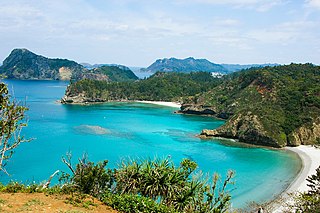
The Ogasawara subtropical moist forests is a terrestrial ecoregion which encompasses the Ogasawara Archipelago of Japan. The Ogasawara Archipelago lies in the Pacific Ocean south of Honshu, Japan's largest island, and north of the Marianas Islands. The ecoregion includes the Bonin Islands and Volcano Islands chains. The islands are volcanic in origin, and have never been linked to a continent. They are home to distinct plants and animals including many endemic species.
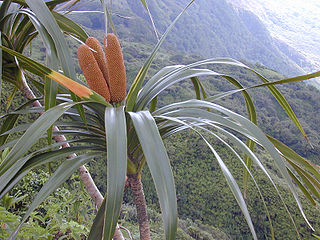
Freycinetia is one of the five extant genera in the flowering plant family Pandanaceae. The genus comprises approximately 180–200 species, most of them climbers.

Livistona is a genus of palms, the botanical family Arecaceae, native to southeastern and eastern Asia, Australasia, and the Horn of Africa. They are fan palms, the leaves with an armed petiole terminating in a rounded, costapalmate fan of numerous leaflets.

Livistona australis, the cabbage-tree palm, is an Australian plant species in the family Arecaceae. It is a tall, slender palm growing up to about 25 m in height and 0.35 m diameter. It is crowned with dark, glossy green leaves on petioles 2 m long. It has leaves plaited like a fan; the terminal bud of these is small but sweet. In summer it bears flower spikes with sprigs of cream-white flowers. The trees accumulate dead fronds or leaves, which when the plant is in cultivation are often removed by an arborist.
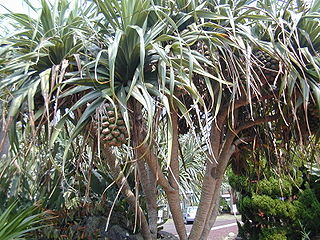
Pandanus boninensis is an Asian species of plant that is endemic to and common in the Distylium-Schima dry forests and Raphiolepis-Livistona dry forests of the Bonin Islands, Japan. It has aerial prop roots and grows on rocks. The beetle, Phylloplatypus pandani is a leaf miner that consumes the leaves of P. boninensis, it was first described by scientists in 1998. The fungus, Kodonospora tetracolumnaris was isolated from dead leaves of P. boninensis and described in 1993.
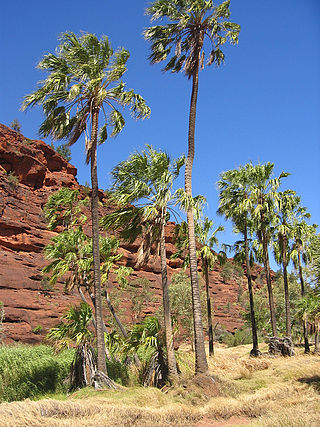
Livistona mariae, also known as the central Australian or red cabbage palm, is a species of flowering plant in the family Arecaceae.

Livistona saribus, also known as the swamp serdang or taraw palm, is a species of palm tree found in tropical Southeast Asia.

Livistona chinensis, the Chinese fan palm or fountain palm, is a species of subtropical palm tree of east Asia. It is native to southern Japan, Taiwan, the Ryukyu Islands, southeastern China and Hainan. In Japan, two notable populations occupy islands near the coast of Miyazaki Prefecture, Aoshima and Tsuki Shima. It is also reportedly naturalized in South Africa, Mauritius, Réunion, the Andaman Islands, Java, New Caledonia, Micronesia, Hawaii, Florida, Bermuda, Puerto Rico and the Dominican Republic.
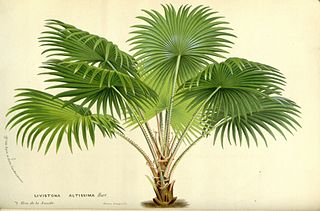
Saribus is a genus of palms, native to Southeast Asia, Papuasia and Pacific Islands. They are fan palms, the leaves with an armed petiole terminating in a rounded, costapalmate fan of numerous leaflets.
Livistona halongensis is a species of palm first collected in Ha Long Bay, Vietnam, in 1999. The species was described by Tiên Hiêp Nguyên and Ruth Kiew in 2000. It is a fan palm.

Livistona decora is a species of palm endemic to the sclerophyll woodlands, rainforests, and coastal strands of Queensland, Australia. It is known only from Magnetic Island near the City of Townsville, and south along the coast as far as Rainbow Beach. The species is now widely cultivated in arid regions worldwide as a decorative plant.

Saribus woodfordii is a species of fan palm which is native to an area from southeastern Papua New Guinea to the Solomon Islands.

Livistona humilis, the sand palm, is an Australian plant species of the family Arecaceae. It is a small, slender palm, growing to about 7 m tall and 5–8 cm dbh. It has 8 to 15 fan-shaped leaves, 30–50 cm long with petioles 40–70 cm long. It is endemic to the Top End of the Northern Territory in Australia. Genetic investigation suggests that its closest relative is Livistona inermis. This palm is fire tolerant and usually grows in environments where it is exposed to frequent fires.
Metrosideros boninensis is a species of flowering plant in the family Myrtaceae. It is endemic to the Bonin Islands archipelago and is found exclusively on Chichijima Island, excepting for two remaining trees located on neighboring Anijima Island. M. boninensis is classified as ‘endangered’ in the Japanese Red Data Book and, although there were 326 plants recorded in 2004, genetic diversity of M. boninensis is extremely low.
Stenomelania boninensis is a species of freshwater snail, an aquatic gastropod mollusc in the family Thiaridae.
Malaxis boninensis is a species of flowering plants in the family Orchidaceae, native to the Bonin Islands and the Volcano Islands, both belonging to Japan. It grows on the ground from pseudobulbs. It was first described by Gen-ichi Koidzumi in 1918, as Microstylis boninensis, and transferred to Malaxis by Kunio Nakajima in 1975.

Anthony Norman Rodd, known as Tony Rodd, is an Australian botanist.

The Bonin Islands are an archipelago of over 30 subtropical and tropical islands, some 1,000 kilometres directly south of Tokyo, Japan and 1,000 miles northwest of Guam.














